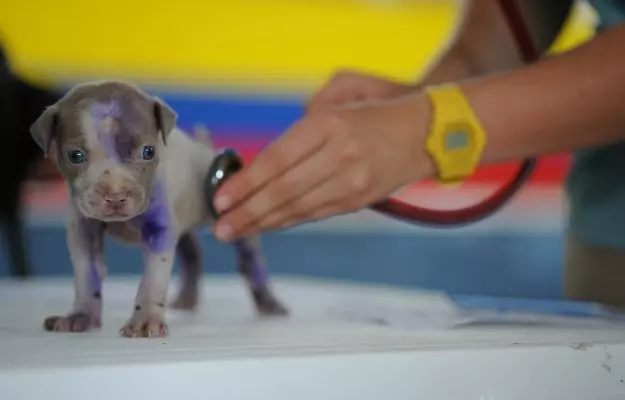Just as our pets know when we’re not feeling so good, we learn to understand when our pets are feeling unwell. And while every sneeze and teary eye isn’t something to worry about, our pets use them to communicate their discomfort to us. One of the things they can signal is canine distemper.
Canine distemper is a viral infection that can make puppies and young dogs very ill. Though distemper in older dogs is rarer, it’s not unheard of.
Caused by the paramyxovirus, also called Canine Distemper Virus (CDV), canine distemper is highly contagious and can be life-threatening. It attacks multiple body systems at the same time, resulting in a widespread infection that is difficult to treat: the virus can invade the respiratory, gastrointestinal and nervous system of the dog’s body.
The symptoms of canine distemper can include sneezing, coughing, discharge from eyes, fever, inactivity, vomiting, diarrhoea and loss of appetite.
Dogs who have had canine distemper in the past can develop problems of the central nervous system later in life.
There is a vaccine for canine distemper, but no medicine. So make sure your veterinary doctor gives the vaccine to your puppy starting at six weeks to eight weeks of age. If your dog is a rescue and you don’t have the proper vaccination history, make sure you tell your veterinarian so they can draw up a proper vaccination plan for your pet.
- Cause of Canine Distemper, and how the infection spreads
- Symptoms of Canine Distemper
- Complications of Canine Distemper
- Diagnosis of Canine Distemper
- Treatment for Canine Distemper
- Prevention of Canine Distemper
Cause of Canine Distemper, and how the infection spreads
Distemper in dogs is caused by a virus called paramyxovirus, which is closely related to measles - a deadly disease seen in humans.
Canine distemper can spread in one of three ways:
- Contact between an infected animal and your dog can facilitate the spread of the virus. The virus can also be transmitted by sharing food and water bowls with the infected animal. The worst part is, distemper-infected dogs can shed the virus for several months, putting dogs around them at risk.
- Just like the common cold in humans, the disease spreads via the air, through infected droplets of bodily secretions from the nose, eyes or mouth. When an infected dog or wild animal coughs, sneezes, or barks, he/she releases aerosol droplets into the environment, infecting nearby animals and surfaces.
- Female dogs can also spread the virus through the placenta to their puppies, which is one of the reasons why it is extremely important to get your dogs vaccinated before breeding.
Symptoms of Canine Distemper
Distemper is commonly seen in young puppies between three months and six months of age but can occasionally be found in young adult or older pets, too.
During the initial stage, the symptoms could present as watery to pus-like discharge from the dog's eyes, followed by fever, loss of appetite, and clear nasal discharge.
Usually, the symptoms associated with distemper in dogs are quite similar to any infection in the body. It's important that pet parents don't ignore these symptoms but keep a close eye as canine distemper can suddenly become much worse. Some of the symptoms to look out for are:
- Persistent fever
- Coughing and vomiting
- Diarrhoea
- Clear nasal discharge
- Pus-filled eye discharge
- Extreme lethargy
- Lack of hunger or anorexia
- Pustular dermatitis (pus-filled pimples or blisters)
Complications of Canine Distemper
Hard pad disease: Even if a dog infected with distemper survives the initial stage of the illness, he/she may develop hyperkeratosis (increased scaling or thickening) of the paw pads and nose, which is clinically called “hard pad disease”. Hard pad disease can cause the pads of a dog’s feet to harden and enlarge, which makes it painful and uncomfortable to walk.
Secondary infection: One of the other risks associated with distemper in dogs is a secondary bacterial infection that attacks when a dog’s immune system is compromised by the distemper virus. It may present with symptoms like vomiting, diarrhoea, breathlessness, change in respiratory rate and pneumonia.
Neurological symptoms: Dogs can also recover completely if treated immediately after the first stage. But if the disease progresses, it may lead to the development of neurological signs in some dogs which attacks the central nervous system.
The severe neurological symptoms may present as:
- Frequent tilting of the head
- Continuous circling
- Seizures (fits)
- Nystagmus (repetitive unintentional back and forth movement of the eyeballs)
- Partial or full paralysis
- Tremors of the head, neck or one or more legs (most often seen when a dog is asleep)
- Stumbling
- Muscle twitching in the entire body
- Convulsions (involuntary contractions of the body) with increased salivation and chewing motions, also known as “chewing gum fits”.
Diagnosis of Canine Distemper
Some of the early symptoms of Canine Distemper can be quite general. Therefore, confirming a diagnosis of Canine Distemper can be hard. Some of the tests that may be used to make or confirm a diagnosis include:
- Antibody test: Your doctor may take samples from the skin under the fur, nasal mucous, and the footpad skin to test for antibodies to fight off distemper (as soon as any foreign entity enters the body, the body starts making antibodies against it. Checking for these antibodies can often be easier than looking for the microorganism itself).
In most cases, however, the test for antibodies gives a false negative. Any way these tests cannot distinguish between the antibodies developed after giving a vaccine and the antibodies formed after exposure to a potent virus. Takeaway: your veterinarian may start distemper treatment even if this test comes back negative.
- Reverse-Transcription Polymerase Chain Reaction: Your vet may also conduct a blood test called a Reverse-Transcription Polymerase Chain Reaction (RT-PCR) test which isolates viral RNA from the dog's blood and recreates a strand of viral DNA. This strand is then magnified to help zero-in on the exact organism which is causing the disease. However, this test can be time-consuming.
- Urine analysis: Distemper in dogs can also be diagnosed with biochemical tests and urine analysis, which may reveal a reduced number of white blood cells that function in the immune system to fight any disease.
- CT scans and MRI: Computed tomography (CT) and magnetic resonance imaging (MRI) scans can be used to examine the brain for any lesions that may have developed as a result of the infection.
However, since these tests are not reliable enough on their own, the veterinarian has to look at the whole picture, including the dog’s specific symptoms and health history, to make a diagnosis. Remember: though positive test results can help confirm an infection, a dog can still be infected even if test results are negative.
Treatment for Canine Distemper
Unfortunately, there is no cure for canine distemper. A dog's chances for surviving canine distemper depend upon the aggressiveness of the virus and the strength of the dog’s immune system.
Full recovery can be made if the disease is diagnosed and treated in the early stages, but the dogs that show neurologic signs generally have a poorer prognosis.
Supportive care could be given to alleviate the symptoms. For instance:
- If your dog has become dehydrated or has diarrhoea, intravenous supportive fluids may be given.
- Discharge from the eyes and nose should be cleaned regularly.
- Your veterinary doctor may prescribe antibiotics to control secondary bacterial infection.
- For dogs who are experiencing convulsions and/or seizures, a veterinary doctor may phenobarbital and potassium bromide to control them.
Once fully recovered, dogs do not spread or carry the virus.
Prevention of Canine Distemper
Vaccination is crucial for preventing canine distemper.
- Vaccination of your puppy should be done right when he/she attains the age of six to eight weeks. Vaccinations should be given every three weeks until your pet is 16 to 20 weeks old.
- A booster vaccination should be given every one to three years, or as decided by your vet after your dog attains the age of five months.
- Use caution when socializing puppies or unvaccinated dogs at parks, puppy classes and other places where dogs can congregate.
References
- American Veterinary Medical Association: Canine Distemper
- "Canine Distemper: A very serious and potentially fatal disease in dogs"; Banfield Pet Hospital, US
- "Distemper in Dogs – Causes, Symptoms, & Treatment", By Anna Burke, November 2016
- Canine Distemper by pets.webmd.com
- Canine Distemper by Blue Cross for Pets, UK
- "Distemper in Dogs", by www.petmd.com














